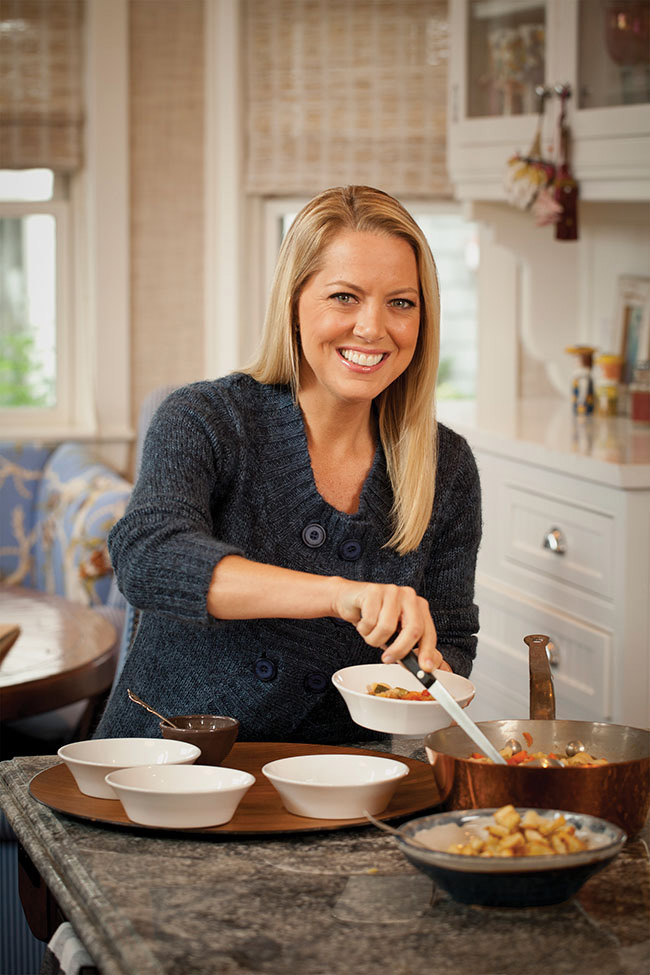Melissa d’Arabian is no stranger to a packed schedule. But the Coronado mom of four, bestselling cookbook author, and nationally acclaimed television host is no stranger to having it all together, either.
In her earlier career, d’Arabian was thriving on the classic corporate America path. She received her MBA from Georgetown University and was enjoying a career in corporate finance and strategy when she met her now husband, Philippe, in Paris. The two moved back to the states where Philippe obtained his MBA at Kellogg University in Illinois (d’Arabian laughs, “Everyone thinks it was the American girl bringing the Parisian boy back to the U.S., but in reality we came here for him!”) and then established a successful career in the computer industry.
When the two began a family, d’Arabian made a career shift to stay-at-home-mom — and with four daughters close in age, her work schedule was a hefty one. One challenge was navigating how to feed four young children healthful food on a sustainable budget — but with a lifelong love for cooking and her sharp financial savvy, d’Arabian discovered how to tackle two birds with one stone and began making her own baby food and yogurt at home. “I was saving $125 to $150 per month on yogurt alone!” she says. The concept was so popular among her friends and family that she began self-recording home-yogurt-making tutorials on her cell phone to share her methods with more moms everywhere. The concept of combining delicious recipes and money-saving techniques spread quickly — and led her to victory on season five of Food Network’s The Next Food Network Star.
The television competition rang true to its name, and d’Arabian is now well known as the star of Food Network’s Ten Dollar Dinners (and is the author of its eponymous New York Times bestselling cookbook). It was a perfect match, as the aim of the show and cookbook (“Four people, ten bucks, infinite possibilities!”) aligns with her original goals of melding good food and financial savvy. She also hosts Cooking Channel’s Drop 5 lbs. with Good Housekeeping and has recently debuted her newest endeavor, Food Network’s web-exclusive series The Picky Eaters Project, an eight-week workshop created to address the picky eating habits of her own children through fun and positive week-by-week steps in order to help other parents do the same.
The project is a true labor of love for d’Arabian as, she jokes, “Two and a half of [her] four children are picky.” One of the cornerstones of the series is getting organized when it comes to transforming a family’s eating routine and establishing positive, healthful, lifelong mealtime habits — and it’s about a lot more than what food to eat. D’Arabian explains, “pickiness is a complex issue that can’t be oversimplified. There’s more to it than simply acclimating palates or a smattering of tips about how to make your kids like different foods. I needed to develop a program that addressed the root causes of picky eating.” So she came up with a strategic, week by week plan to shift her family’s eating habits from persnickety to more adventurous.
Above all, d’Arabian aims to set up habits that support positive relationships with food and eating. She says of her four daughters, “I want them to grow up having respect for their bodies, knowledge of how food nourishes them, and awareness of the positive power of sharing a meal with others.” She explains that it’s not about finding tricky ways to force one’s children to unhappily choke down broccoli — rather, it’s about creating positive associations with food that will last a lifetime. For her, that means having family dinner around the table, sharing stories about the day during mealtime, keeping meals at the same time every day, teaching children about the nutritional value of food, getting them involved in menu planning, grocery shopping, and food preparation, guiding and empowering kids in making their own healthful food choices, and integrating slow and strategic alterations to favorite foods to encourage more adventurous eating — all in a positive, non-punitive way. A bonus about doing all these things in Coronado? “Coronado has very sophisticated taste for a small town. Not only is it family and community oriented, but we also have three grocery stores and a farmers’ market, all of which are conducive to these types of goals,” says d’Arabian.
But when it comes to the holidays, healthy eating, time management, and established routines can fly out the window. Amid all the seasonal bustle and celebration, d’Arabian takes the same approach with her family’s eating routine and habits as she does with her own holiday diet. She suggests, “Loosen the reigns a little bit, enjoy things in moderation, and do your best to keep the good habits going knowing that a little wiggle room is OK.” Moreover, she explains, “The holidays can even be a great time to encourage kids to try new foods and develop a more adventurous palate — and have a positive association with doing so.” And, as far as those very busy holiday schedules go, d’Arabian warns against falling into the trap of thinking if something isn’t done perfectly it shouldn’t be done. She says, “It’s not about perfection, it’s about progress. If one piece of the puzzle is missing, don’t throw the whole puzzle away. If you’re too busy to cook one night and order pizza instead, just make sure you keep up the other important family eating routines like sitting down at the table together to eat and sharing stories about your day.”
And it seems that her advice is good. Despite her very full plate, d’Arabian’s way of keeping it all together is so effective that she even has time every December to host a much-anticipated annual mother/daughter tea for about 150 of her family and friends. D’Arabian and her children are blessed to have such a large network of friends in large part because of the nature of community on the island. She and Philippe made a conscious choice to relocate here and instantly knew it was the right place for their family. She says, “The kids take care of one another across all grade levels and there’s a huge sense of community between the parents and the children. My kids are so lucky to have role models all around them, outside of just their own parents.”
She holds the tea the week following Thanksgiving. “We always put up the Christmas decorations the day after Thanksgiving,” she says, which sets the mood for the holiday season. For the event, she collects different types of teacups to serve festive teas and spends days preparing all sorts of yummy dishes for her guests. Her potato bacon torte is one of the highly coveted wintertime treats her guests look forward to every year.
D’Arabian shared how she has often longed after the beautiful images between the covers of Sunset magazine and, sitting on her plush white couch, her happy Labrador lounging on the rug, surrounded by portraits of her lovely family, the water fountain tinkling away in the backyard beyond, she doesn’t seem too far off from her own spread in the magazine. But there was one image in particular she’s wanted to make her own for years — an enchanted family Thanksgiving feast set up along the beach (she pictures guests wrapped in cozy cardigans, sharing soft blankets, a bonfire blazing…). Each year around the holidays she’s dreamed of creating this magical scene on her own but the season always seems to come and go with no spare time to do so. Perhaps, however, this will be the year. It wouldn’t be at all surprising if this financial guru, chef extraordinaire, vibrant television personality, and dedicated mother of four pulls it off with gusto.
Melissa d’Arabian’s 10 tricks to make picky eaters more adventurous and boost mealtime morale
1 Get the family buy in. Begin transforming picky eaters by having a family meeting and making sure they are aware of and on board with the plan. Set goals together and allow everyone’s input.
2 Reorganize the pantry so that healthy foods are more accessible to the kids. Place treats higher up in opaque containers; put healthier snacks in clear, easy-to-reach containers.
3 Use a three-ring binder to keep your goals and progress organized. Include a list of foods your children love to eat and the variations on them to help with your meal planning. Incorporate a “daily victory file” to track your successes. Celebrate your progress!
4 Build a constructive routine around mealtimes. Have a clear start and stop time for dinner at the same time every night so kids don’t get overly hungry and grouchy. Set the dinner table earlier in the day so you aren’t rushed. You can even try incorporating something fun such as letting the kids ring a dinner bell when it’s being served.
5 Create positive associations with mealtime. Start by serving lots of family favorites so kids are excited to come to the table. Have your children share happy stories from their day to encourage upbeat family bonding time.
6 Give your kids a voice in the process. Have them make “taste test” books to record the new foods they’ve tried and how they feel about them. At mealtime, serve open quantity portions of healthy foods like fruits and vegetables, so they are able to choose their own portion size. For desserts, serve small, bite-size portions and allow your kids to choose if they want one or two (knowing that two bite-size portions are still smaller than one regular-size portion). Serve two varieties of vegetables with dinner so they can opt for their favorite. By giving them a choice, you’re encouraging positive relationships with food and empowering them to have a say in what and how much they eat.
7 Empower your kids with knowledge about nutrition — but keep it simple and fun. Explanations such as “protein builds muscle” and “fiber scrubs out our insides” teach kids in easy-to-understand ways how foods nourish us. Make it fun by teaching them about food at farmers markets, or go to local farms to learn about the produce. At mealtime, allow your kids to explain how what you’re eating is feeding your bodies.
8 Make transitions slow and steady. Start by making slight variations on foods you know your kids like (for example, serve shells and cheese instead of macaroni and cheese). Transition gradually from “hook” foods to “goal” foods. (For example, start with store-bought chicken nuggets you know your kids love, to homemade chicken nuggets, to a Chicken Milanese you’d happily serve to adult guests — slowly bridging the gap between “kid” foods and “adult” foods.
9 Make cooking and food preparation a family affair. Have your kids help with the recipes and putting meals together – but not when you’re rushed. Do it when you have the time to make it a fun activity rather than just a means to make food.
10 Incorporate tons of fun, active family activities. Go for a family bike ride, walk, or just turn on some music and dance! Doing so will increase your kids’ appetites, and bigger appetites mean less picky eating!






